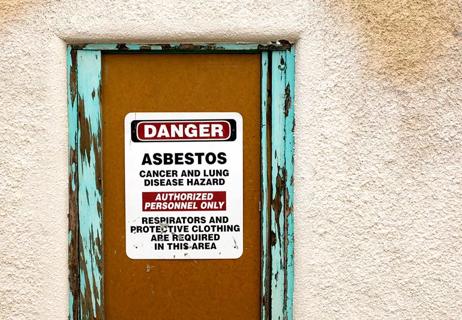6 tips for protecting your lungs while you work

Did you know that do-it-yourself home improvement projects are sometimes hazardous to your health? (And we’re not just talking about falling off of a ladder.)
Advertisement
Cleveland Clinic is a non-profit academic medical center. Advertising on our site helps support our mission. We do not endorse non-Cleveland Clinic products or services. Policy
These projects are a source of pride and enjoyment for many homeowners. But it’s a good idea to assess and address the risks before you begin. Otherwise, you may expose yourself and your family to harmful substances that cause serious lung problems and other health concerns.
There are several potentially dangerous common substances you’ll likely encounter during a DIY project, according to pulmonary medicine specialist Lamia Ibrahim, MD.
Here’s a rundown on six of the most common hazards, followed by hints to help keep you and your loved ones safe:
Hazard: Builders used asbestos in construction for decades because it is chemical- and fire-resistant. The most common places you’ll find asbestos are in floor and ceiling tiles, insulation, cement, plaster and roofing materials.
If you damage asbestos, it releases tiny fibers into the air. Over time, those fibers can cause scar tissue in the lungs (asbestosis), lung cancer or mesothelioma (a cancer that affects the lining of the lungs or other organs).
Helpful hint: If you run across anything you think might be asbestos, stop what you’re doing immediately and call someone trained in asbestos removal. You can find qualified professionals online under “Asbestos Abatement & Removal.”
Advertisement
Hazard: If you work without proper ventilation, paint fumes can cause watery eyes, headache and nausea. Paint solvents that contain methylene chloride also cause dizziness and shortness of breath.
Helpful hint: Always make sure to have adequate ventilation when painting. It’s also a good idea to wear a mask to protect your lungs.
Myth buster: Some people suggest wrapping and storing paintbrushes or rollers in the refrigerator so they won’t dry out, but it’s not a good idea unless you take the right precautions.
“Unless everything is well covered with plastic wrap, the paint can give off fumes that may contaminate any uncovered food — or even potentially affect covered food, as well,” Dr. Ibrahim says.
Hazard: If your home was originally built before 1978, it most likely contains lead-based paint. Lead is released into the air while you’re sanding or if the paint somehow becomes heated.
Lead is a dangerous poison for everyone, but especially for young children and developing fetuses, Dr. Ibrahim says.
In children, lead damages the brain and nervous system as they develop. At high levels, it causes seizures, coma and even death. For adults, high levels of lead can cause high blood pressure, kidney disease and problems with the nervous system.
Helpful hint: Before you renovate an older home, have the paint tested for lead content. You can buy a lead-test kit that’s approved by the U.S. Environmental Protection Agency at the hardware store.
“If lead paint is present and is intact, the best option is usually to cover it up so that it can’t flake or deteriorate,” says Dr. Ibrahim.
For major renovations, it’s a good idea to hire a certified contractor to test the paint and remove it if it contains lead.
Hazard: Dust from any source (like wood sanding or cutting or removing drywall) can cause serious health problems. Exposure to dust is associated with asthma, lung inflammation and chronic bronchitis.
Contact with dust can also cause dermatitis (skin inflammation) or other allergic reactions.
Hint: There are several things you can do to prevent exposure to dust:
Advertisement
Hazard: Mold is sometimes found under carpet, wallpaper or tiles. It also lurks behind mirrors, under kitchen or bathroom sinks, or inside cabinets. Exposure to mold typically causes nasal stuffiness, eye irritation, wheezing, skin irritation, fever or shortness of breath.
Helpful hint: Check your home for sources of moisture which may mean mold is present. If you suspect or smell mold, hire an independent mold inspector (certified by the Indoor Air Quality Association) to survey your home.
When removing grout, watch out for mold that may have grown in the tile.
Those with allergies to mold, especially asthma, should wear a protective mask or avoid the area altogether.
Hazard: Prolonged exposure to grout sealer in a poorly ventilated area can cause mild respiratory problems, such as shortness of breath and exacerbation of asthma.
Helpful hint: Make sure you have adequate ventilation and/or wear a mask when applying grout sealer.
Taking steps to assess hazards and protect your lungs before you start a DIY home improvement project will help every project go more smoothly. You won’t have to waste time dealing with discomfort or other health problems along the way.
Advertisement
Learn more about our editorial process.
Advertisement

How to protect your family from exposure

Most recommended precautions center around minimizing bruising or swelling

Even one drink can have an impact on your cognitive function leading to slurred speech, blurred vision and impaired memory

Understand who may (and may not) benefit

Lorem ipsum dolor sit amet. Et odio Quis vel ipsam omnis eum alias deleniti et placeat impedit non voluptas galisum hic autem enim et cupiditate aliquid. Est beatae quidem non facilis autem ut commodi nisi aut tempore rerum et dolores voluptatem cum enim optio id sapiente quasi. Ad laboriosam officiis 33 cupiditate sequi ea voluptatum consectetur qui necessitatibus voluptate et quasi doloremque et facere explicabo quo explicabo officia

Seeking help through therapy can be an important step in improving your quality of life when you have UC

Type 2 diabetes isn’t inevitable with these dietary changes

Applying a hot or cold compress can help with pain